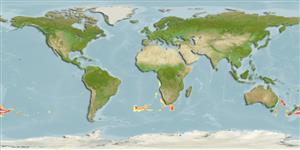Pycnogonida |
Pantopoda |
Phoxichilidiidae
Environment: milieu / climate zone / ระดับความลึก / distribution range
นิเวศวิทยา
สัตว์หน้าดินในเขตน้ำลึก; ระดับความลึก 1586 - 3550 m (อ้างอิง 9). Temperate
Southwest Pacific and Southeast Atlantic: New Zealand and South Africa.
Length at first maturity / ขนาด / Weight / Age
วัยเจริญพันธุ์: Lm ? range ? - ? cm Max length : 2.9 cm LS เพศผู้/กระเทย; (อ้างอิง 170)
Almost opposite of Anoplodactylus pycnosoma; long and slender, with long, well separated lateral processes, tall tapered and sometimes blind ocular tubercle, very long ovigers, and relatively long legs with one major heel spine on each propodus. Male single cement gland situated on swollen bump in distal half of femora and is a very short tube.
Among the deepest depths known for any member of this genus.
Life cycle and mating behavior
วัยเจริญพันธุ์ | การสืบพันธุ์ | การวางไข่ | Eggs | ความดกของไข่ | Larvae
Members of the class Pycnogonida are gonochoric and sexually dimorphic. During copulation, male usually suspends itself beneath the female. Fertilization occurs as the eggs leave the female's ovigers. Males brood the egg masses until they hatch. Life cycle: Eggs hatch into protonymphon larva then to adults.
Child, C.A. 1998 The marine fauna of New Zealand: Pycnogonida (sea spiders). NIWA Biodiversity Memoire 109. National Institute of Water and Atmospheric Research (NIWA). Washington, D.C. 20530, USA. 71 p. + Figure 2A-G, 3A-F, 4, 5. (อ้างอิง 9)
IUCN Red List Status
(อ้างอิง 130435: Version 2025-1)
CITES status (อ้างอิง 108899)
Not Evaluated
CMS (อ้างอิง 116361)
Not Evaluated
Threat to humans
Harmless
Human uses
| FishSource |
เครื่องมือ
ข้อมูลเพิ่มเติม
นิเวศวิทยาเขตร้อนFood items (preys)
องค์ประอบของอาหาร
การบริโภคอาหาร
ผู้ล่า
Population dynamicsการเจริญเติบโต
Max. ages / sizes
Length-weight rel.
Length-length rel.
Length-frequencies
Mass conversion
อุดมสมบรูณ์
Life cycleการสืบพันธุ์วัยเจริญพันธุ์ความดกของไข่การวางไข่EggsEgg developmentLarvae Human RelatedStamps, coins, misc.
แหล่งที่มาจากอินเตอร์เน็ต
Estimates based on models
Preferred temperature
(Ref.
115969): 1.9 - 2.9, mean 2.4 (based on 60 cells).
Fishing Vulnerability
Low vulnerability (10 of 100).
Price category
Unknown.
